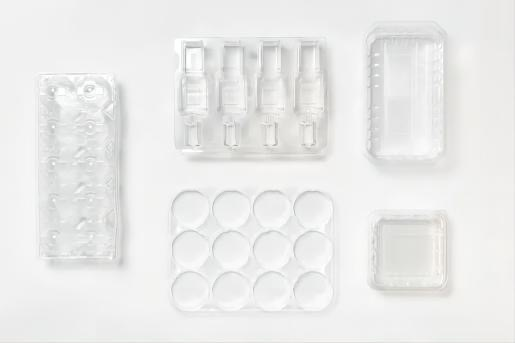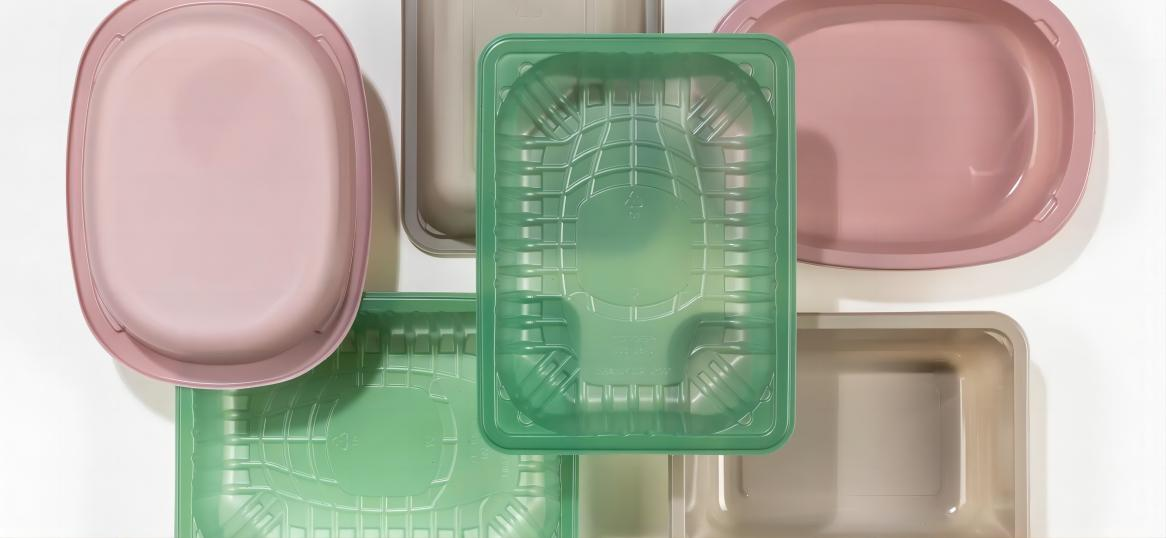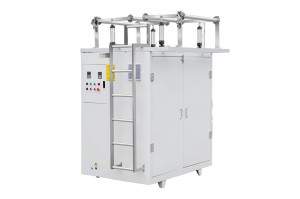RM-3 Three-station Thermoforming Machine
Machine Parameters
| ◆Model: | RM-3 |
| ◆Max.Forming Area: | 820*620mm |
| ◆Max.Forming Height: | 100mm |
| ◆Max.Sheet Thickness(mm): | 1.5 mm |
| ◆Max Air Pressure(Bar): | 6 |
| ◆Dry Cycle Speed: | 61/cyl |
| ◆Claping Force: | 80T |
| ◆Voltage: | 380V |
| ◆PLC: | KEYENCE |
| ◆Servo Motor: | Yaskawa |
| ◆Reducer: | GNORD |
| ◆Application: | trays, containers, boxes, lids, etc. |
| ◆Core Components: | PLC, Engine, Bearing, Gearbox, Motor, Gear, Pump |
| ◆Suitable Material: | PP.PS.PET.CPET.OPS.PLA |
| Max. Mould Dimensions |
Clamping Force | Dry Cycle Speed | Max. Sheet Thickness |
Max.Foming Height |
Max.Air Pressure |
Suitable Material |
| 820x620mm | 80T | 61/cycle | 1.5mm | 100mm | 6 Bar | PP, PS, PET, CPET, OPS, PLA |
Product Video
Function Diagram

Main Features
✦ Efficient production: The machine adopts an automatic control system, which can quickly and efficiently complete the molding, cutting and palletizing of plastic products. It has the functions of rapid heating, high pressure forming and precise cutting, which greatly improves the production efficiency.
✦ Flexible and diverse: This machine is equipped with multiple stations, which can be adapted to the production of different types and sizes of plastic products. By changing the mould, products of various shapes can be produced, such as plates, tableware, containers, etc. At the same time, it can also be customized according to the needs to meet the special needs of different customers.
✦ Highly automated: The machine has an automated operation and control system, which can realize an automated production line. It is equipped with automatic feeding, automatic forming, automatic cutting, automatic palletizing and other functions. The operation is simple and convenient, reducing manual intervention and reducing the cost of human resources.
✦ Energy saving and environmental protection: The machine adopts a high-efficiency heating system and energy-saving design, which can minimize energy consumption. At the same time, it also has precise temperature control and emission purification system, which reduces the pollution to the environment.
Application Area
The 3-station thermoforming machine is suitable for food packaging, catering industry and other fields, providing convenience and comfort for people's life.


Tutorial
Equipment Preparation:
Ensure the 3-station thermoforming machine is securely connected and powered on, with all safety measures in place to avoid any mishaps during operation.
Conduct a thorough inspection of the heating system, cooling system, pressure system, and other functions to verify that they are functioning normally and ready for production.
Carefully install the required molds, double-checking to ensure that they are securely fastened in place, minimizing the risk of misalignment or accidents during the molding process.
Raw Material Preparation:
Begin the process by preparing a suitable plastic sheet for molding, ensuring it meets the necessary size and thickness specifications required by the molds.
Select high-quality plastic materials that will provide optimal results during the thermoforming process, enhancing the efficiency and overall quality of the final products.
Heat Settings:
Access the control panel of the thermoforming machine and set the heating temperature and time appropriately, taking into consideration the specific plastic material being used and the mold requirements.
Allow the thermoforming machine sufficient time to reach the designated temperature, guaranteeing that the plastic sheet becomes pliable and ready for molding.
Forming - Cutting - Stacking and Palletizing:
Gently place the preheated plastic sheet onto the mold surface, ensuring it is perfectly aligned and free from any wrinkles or distortions that could compromise the forming process.
Initiate the molding process, carefully applying pressure and heat within the specified time frame to shape the plastic sheet precisely into the desired form.
Once the forming is complete, the newly shaped plastic product is left to solidify and cool within the mold, before proceeding to cut, and orderly stacking for convenient palletizing.
Take Out the Finished Product:
Inspect each finished product meticulously to ensure it conforms to the required shape and adheres to the established quality standards, making any necessary adjustments or rejections as needed.
Cleaning and Maintenance:
Upon completion of the manufacturing process, power down the thermoforming machine and disconnect it from the power source to conserve energy and maintain safety.
Thoroughly clean the molds and equipment to eliminate any residual plastic or debris, preserving the molds' longevity and preventing potential defects in future products.
Implement a regular maintenance schedule to inspect and service various equipment components, guaranteeing that the thermoforming machine remains in optimal working condition, promoting efficiency and longevity for continuous production.














